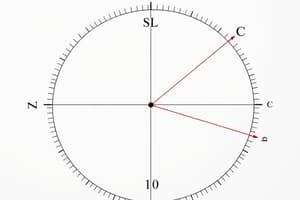Podcast
Questions and Answers
What is the value of sin $
rac{ ext{pi}}{3}$?
What is the value of sin $ rac{ ext{pi}}{3}$?
- $ rac{ ext{3}}{ ext{4}}$
- $ rac{ ext{√3}}{ ext{2}}$ (correct)
- $ rac{ ext{√2}}{ ext{2}}$
- $ rac{ ext{1}}{ ext{2}}$
If secx = $
rac{13}{5}$, what is cos 2x?
If secx = $ rac{13}{5}$, what is cos 2x?
- $ rac{13}{12}$
- $ rac{5}{13}$
- $- rac{12}{13}$ (correct)
- $ rac{60}{169}$
Which identity correctly represents $ an 2 heta$?
Which identity correctly represents $ an 2 heta$?
- $ rac{1 - ext{cos} 2 heta}{ ext{sin} 2 heta}$
- $ rac{1 - ext{cos} 2 heta}{1 + ext{cos} 2 heta}$ (correct)
- $ rac{ ext{sin} 2 heta}{1 - ext{cos} 2 heta}$
- $ rac{1 + ext{cos} 2 heta}{ ext{sin} 2 heta}$
In the identity $( ext{cos}2x - ext{cos}2y)^2 + ( ext{sin}2x - ext{sin}2y)^2 = 4 ext{sin}^2(
rac{x+y}{2}) ext{sin}^2(
rac{x-y}{2})$, what is being demonstrated?
In the identity $( ext{cos}2x - ext{cos}2y)^2 + ( ext{sin}2x - ext{sin}2y)^2 = 4 ext{sin}^2( rac{x+y}{2}) ext{sin}^2( rac{x-y}{2})$, what is being demonstrated?
Which of the following correctly simplifies the expression $
rac{ ext{cos}x + ext{sin}x}{ ext{cos}x - ext{sin}x} -
rac{ ext{cos}x - ext{sin}x}{ ext{cos}x + ext{sin}x}$?
Which of the following correctly simplifies the expression $ rac{ ext{cos}x + ext{sin}x}{ ext{cos}x - ext{sin}x} - rac{ ext{cos}x - ext{sin}x}{ ext{cos}x + ext{sin}x}$?
Study Notes
Trigonometric Values
- Sine and Cosine:
- ( \sin \frac{\pi}{3} = \frac{\sqrt{3}}{2} )
- ( \cos \frac{\pi}{3} = \frac{1}{2} )
Sine, Cosine, and Tangent Calculations
- Given ( \sec x = \frac{13}{5} ), calculate:
- Since ( \sec x = \frac{1}{\cos x} ), then ( \cos x = \frac{5}{13} ).
- Use ( \sin^2 x + \cos^2 x = 1 ) to find ( \sin x = -\frac{12}{13} ) (as ( -\frac{\pi}{2} < x < \frac{\pi}{2} )).
- Calculate ( \sin 2x = 2 \sin x \cos x = 2 \left(-\frac{12}{13}\right) \left(\frac{5}{13}\right) = -\frac{120}{169} ).
- Calculate ( \cos 2x = 2 \cos^2 x - 1 = 2 \left(\frac{5}{13}\right)^2 - 1 = -\frac{119}{169} ).
- Calculate ( \tan 2x = \frac{\sin 2x}{\cos 2x} = \frac{-\frac{120}{169}}{-\frac{119}{169}} = \frac{120}{119} ).
Trigonometric Proofs
-
Proof i:
- Prove ( \frac{1 - \cos 2\theta}{1 + \cos 2\theta} = \tan^2 \theta ) via identities.
-
Proof ii:
- Establish ( (\sin^2 t - \sin^2 x)\sin(x+t) + (\cos^2 t - \cos^2 x)\cos(x+t) = 0 ) using trigonometric identities.
-
Proof iii & iv:
- Show ( (cos^2 x - cos^2 y)^2 + (sin^2 x - sin^2 y)^2 = 4\sin^2(\frac{x+y}{2})\sin^2(\frac{x-y}{2}) ), using the Pythagorean identities.
-
Proof v:
- Demonstrate ( \tan x + \cot x = 2 \csc 2x ) with the addition formulas for tangent and cotangent.
-
Proof vi:
- Prove ( \frac{\cos x + \sin x}{\cos x - \sin x} - \frac{\cos x - \sin x}{\cos x + \sin x} = 2\tan 2x ) through algebraic manipulation.
-
Proof vii:
- Establish ( \sqrt{2 + \sqrt{2 + \sqrt{2 + \cos x}}} = 2 \cos(\frac{x}{8}) ) using nested radical properties.
-
Proof viii:
- Prove ( 16 \sin x \cos x \cos 2x \cos 4x \cos 8x = \sin 16x ) using product-to-sum formulas.
-
Proof ix:
- Show ( \frac{\sin 3x + \cos 3x}{\sin x + \cos x} = 2 \cos 2x ) using angle addition formulas and simplifications.
Studying That Suits You
Use AI to generate personalized quizzes and flashcards to suit your learning preferences.
Description
This quiz covers the fundamental concepts of trigonometric values, including sine, cosine, and tangent calculations. You will find specific examples and proofs related to these functions. Test your understanding of the relationships and identities in trigonometry.




